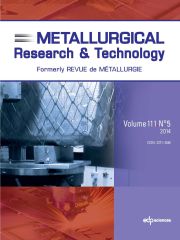Article contents
Synthesis of functional porous metallic material from metallic glass composites precursor by powder metallurgy route
Published online by Cambridge University Press: 13 March 2012
Abstract
Bulk metallic glasses foams are under consideration as highly functional material, such as energy absorbers or ultra-lightweight parts, due to their porous structure combined with desirable strengths at relatively low densities. Also, the characteristics of high surface area of foams synthesized from metallic glasses make them viable candidates as emerging materials such as high-sensitivity sensors, catalysts or hydrogen storage media. In current study, bulk metallic glass foams were fabricated by extruding powder mixtures comprised of metallic glasses blended with various kinds of fugitive phases followed by dissolution of the fugitive phases in an aqueous chemical solution, for example HNO3, to yield the final porous structure. As a result of dissolution process, porous metallic glass having uniformly distributed micro-scale porosity was fabricated using a sequential synthesis technique beginning with composite particles comprised of composites of MG and a fugitive phase followed by consolidation of the composite powders via warm extrusion.
- Type
- Research Article
- Information
- Copyright
- © EDP Sciences 2012
References
- 2
- Cited by


